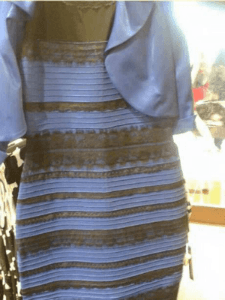Is the blue and black versus white and gold dress illusion a new discovery?: originally appeared on Quora: The best answer to any question. Ask a question, get a great answer. Learn from experts and access insider knowledge. You can follow Quora on Twitter, Facebook, and Google+.
Answer by Paul King, Computational Neuroscientist, Redwood Center for Theoretical Neuroscience
This illusion is pretty fascinating. It might actually point the way to a new discovery.
The color constancy effect has been known for a long time, and there are many illusions around that show (to the same viewer) how a colored surface can appear to be one hue or another depending on the circumstances.
There are two things that are surprising about this particular image:
- Unlike many dual-interpretation illusions, this one is really stable. People see it one way or another, and there is very little that can be done to change their perception.
This raises two interesting questions: What is it about this particular image? And what does this say about possible differences in people's visual systems?
There are a few qualities about this particular image that may explain why it is triggering a unique illusion:
- The visual system processes color at the earliest stages in two parallel neural pathways. One is a blue-yellow information channel and the other is red-green (as in red-green colorblindness). This illusion has something going on in the blue-yellow channel, it would appear. The blue-yellow channel is the oldest one, in case that matters.
The "colors" that are the subject of debate are some of the most ambiguous colors that the brain processes. White, black, and gold are all unusually problematic for the brain for different reasons that all have to do with context. More on that later. Unlike a lot of illusions that show colors in the abstract, e.g. colored tiles over other colored tiles, this one shows a concrete, tangible, familiar object: a dress with texture and highlights in a "just photographed" context. This makes it feel real and incontrovertible. And because it seems like a concrete object, it is hard to "unsee" the version that struck you first once you have seen it (if that is what is going on).What is special about white, black, and gold?
White, black, and gold are all particularly ambiguous as colors go.
A white shirt under red, blue, or green light still looks white, even though the light coming off of it is a "pure color".
Black is never really black, because if it was, you wouldn't see it. True black looks like a hole or featureless void. Black fabric still has texture and shades and a surface appearance even though it is "black." The non-black component of black is attributed by the visual system as a reflection of ambient light in the environment -- a point that is key to this particular illusion. For more information on black, see What is black?
Gold is particularly problematic for two reasons. First off, it's not a real color. There is no "gold" in the rainbow. Gold is an illusion created when yellow light is overlaid with a "metallic" appearance. Metallic, in turn, is a visual effect caused by "specular reflection", which is evidenced by sharp transitions of superimposed white light (the "shininess" of metal). The second problem with gold is the "yellow" part of it. Yellow can be composed of red & green light (with no yellow light mixed in) and changes color depending on luminosity and context. The brown of brown shoes is the same hue as the yellow of the sun, just darker relative to the surrounding.
So given the involvement of three of the more ambiguous colors, it is not surprising that they could form the basis of a striking illusion.
What might this say about differences in people's visual systems?
This is perhaps the most intriguing aspect of this illusion.
Vision neuroscientist and Quora member Pascal Wallisch writes about this illusion in an article on Slate: An Expert's Lessons From the Dress: Why Don't We All See the Same Thing?
Pascal proposes two possibilities: that it could be due to differences in the color receptor make-up of different people's retinas (which are known to vary from person to person), and that it could be a temporal adaptation effect (once you have seen it one way, you can't unsee it).
I'll toss out a third possibility: people's internal color processing systems could actually be different, possibly shaped by experiences of understanding the visual world from early childhood.
Why do some people see the world in "black & white" and others in "shades of gray"? Why do people brought up reading from right-to-left (e.g. Hebrew, Arabic) give attention to the right side first? Why do people have favorite colors that are different?
This dress illusion may finally help us answer a centuries-old question from philosophy: do people perceive colors the same way?
Our 2024 Coverage Needs You
It's Another Trump-Biden Showdown — And We Need Your Help
The Future Of Democracy Is At Stake
Our 2024 Coverage Needs You
Your Loyalty Means The World To Us
As Americans head to the polls in 2024, the very future of our country is at stake. At HuffPost, we believe that a free press is critical to creating well-informed voters. That's why our journalism is free for everyone, even though other newsrooms retreat behind expensive paywalls.
Our journalists will continue to cover the twists and turns during this historic presidential election. With your help, we'll bring you hard-hitting investigations, well-researched analysis and timely takes you can't find elsewhere. Reporting in this current political climate is a responsibility we do not take lightly, and we thank you for your support.
Contribute as little as $2 to keep our news free for all.
Can't afford to donate? Support HuffPost by creating a free account and log in while you read.
The 2024 election is heating up, and women's rights, health care, voting rights, and the very future of democracy are all at stake. Donald Trump will face Joe Biden in the most consequential vote of our time. And HuffPost will be there, covering every twist and turn. America's future hangs in the balance. Would you consider contributing to support our journalism and keep it free for all during this critical season?
HuffPost believes news should be accessible to everyone, regardless of their ability to pay for it. We rely on readers like you to help fund our work. Any contribution you can make — even as little as $2 — goes directly toward supporting the impactful journalism that we will continue to produce this year. Thank you for being part of our story.
Can't afford to donate? Support HuffPost by creating a free account and log in while you read.
It's official: Donald Trump will face Joe Biden this fall in the presidential election. As we face the most consequential presidential election of our time, HuffPost is committed to bringing you up-to-date, accurate news about the 2024 race. While other outlets have retreated behind paywalls, you can trust our news will stay free.
But we can't do it without your help. Reader funding is one of the key ways we support our newsroom. Would you consider making a donation to help fund our news during this critical time? Your contributions are vital to supporting a free press.
Contribute as little as $2 to keep our journalism free and accessible to all.
Can't afford to donate? Support HuffPost by creating a free account and log in while you read.
As Americans head to the polls in 2024, the very future of our country is at stake. At HuffPost, we believe that a free press is critical to creating well-informed voters. That's why our journalism is free for everyone, even though other newsrooms retreat behind expensive paywalls.
Our journalists will continue to cover the twists and turns during this historic presidential election. With your help, we'll bring you hard-hitting investigations, well-researched analysis and timely takes you can't find elsewhere. Reporting in this current political climate is a responsibility we do not take lightly, and we thank you for your support.
Contribute as little as $2 to keep our news free for all.
Can't afford to donate? Support HuffPost by creating a free account and log in while you read.
Dear HuffPost Reader
Thank you for your past contribution to HuffPost. We are sincerely grateful for readers like you who help us ensure that we can keep our journalism free for everyone.
The stakes are high this year, and our 2024 coverage could use continued support. Would you consider becoming a regular HuffPost contributor?
Dear HuffPost Reader
Thank you for your past contribution to HuffPost. We are sincerely grateful for readers like you who help us ensure that we can keep our journalism free for everyone.
The stakes are high this year, and our 2024 coverage could use continued support. If circumstances have changed since you last contributed, we hope you'll consider contributing to HuffPost once more.
Already contributed? Log in to hide these messages.


